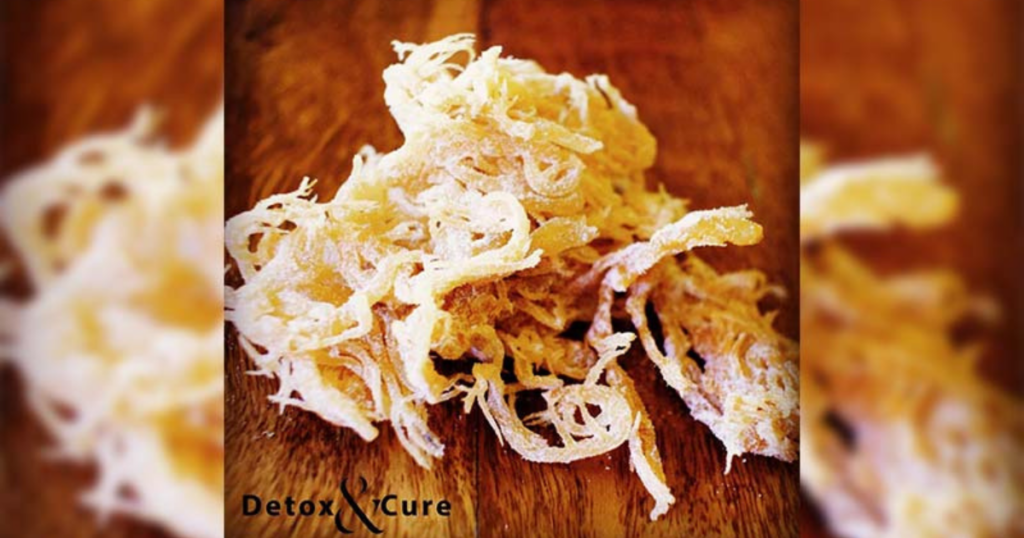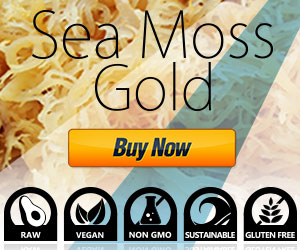Fixing leaky gut may be possible with a little known seaweed. How? It is through the long-chain polysaccharides found in some seaweeds that research has begun to shine an interesting light.
Long chain polysaccharides, such as those found in certain types of fiber, can help improve gut health by promoting the growth of beneficial bacteria in the gut.
This can help to improve the integrity of the gut barrier, which can help to reduce the symptoms of a “leaky gut.” Additionally, these fibers can help to promote regular bowel movements, which can also help to improve gut health and reduce the symptoms of a leaking gut.
Table of Contents
How can Seaweed help Fix Leaky Gut?
Healing or fixing leaky gut naturally is possible, but you need to line a few things up first. So, let’s take a look at some of the foundations that you might not have seen before. First up, what is it that seaweeds can bring to the table?
Being a rich source of minerals and full of helpful prebiotics, they can be a great cornerstone to a healthy diet. In fact, some people choose to undertake Sea Moss fasts where all they consume for a period of time is water and Sea Moss.
This is understood to help take digestive pressure off the gut, while delivering the needed elements through the seaweed for healing.
Before embarking on a fast of any kind it is worth discussing your circumstances with your trusted Doctor or Dietitian.
This seaweed supports specific healthy bodily functions, which in turn helps to improve gut health. Being Polyphenol-rich and playing a key part in promoting healthy cellular division and growth while limiting abnormal cellular growth and division, it also supports wound healing. 1 2 3
So this is great for understanding how it can help with the healing process and fixing leaky gut. But what about after that when it comes to supporting a healthy gut environment? This is where we will touch upon the prebiotic side of things a little more.
After all, a healthy gut environment has a healthy bacteria balance.
Why is Bacteria Necessary to have Good Gut Health?
For the best part of thirty-five years I can speak on having an awareness of the part that good bacteria have to play in promoting good gut health.
Right back to when I first found out about probiotics like lactobacillus acidophilus, good gut health was something that had been around for quite some time before I became conscious of it. But it’s not just about probiotics. 4
There is a need to provide the good gut bacteria in your system with food so they can thrive. This is found in the prebiotics that Sea Moss and other seaweeds can offer.
Being high fibre and non-digestible, this source of food for your good gut bacteria prevents them from looking for alternative food sources, which typically ends up being the mucus lining found in your gut. 5
So feeding these little critters what they need to stop them from going rogue is pretty important. It’s a bit like forgetting to feed your cats to find out that when you get home they have torn apart the kitchen, sofa, and most of your books.
A source of prebiotics as food for your good gut bacteria can greatly reduce the risk of Irritable Bowl Syndrome (IBS) and leaky gut.
“If someone wishes for good health, one must first ask oneself if he is ready to do away with the reasons for his illness. Only then is it possible to help him.”
Hippocrates
A case of poor gut health is often a reflection of an imbalance in the diversity of good gut bacteria. This is normally identified by the individual living with the symptoms as a problem with dairy, wheat, or something else in their diet.
Typically this shows up as a lactose or gluten intolerance. Making Sea Moss a part of your diet could help to increase the diversity of bacteria that aid effective digestion. 6
But what do these ‘good’ gut bacteria do? If they are likely to turn on you and eat the lining of your gut, are they really ‘good’ after all? They play a key part in helping with the digestion process.
Not everything you eat will be digestible as it stands. It will need these good gut bacteria to step in and help handle the load.

What these bacteria tend to do is produce acids (lactic acid) which help with the assimilation and absorption of various minerals in the gut. Without them, the uptake of things like iron, copper, calcium, magnesium, and zinc is a lot lower than what is needed to maintain good functioning bodily health.
Using Sea Moss (referred to by some as Irish Sea Moss), correctly known as Kappaphycus alvarezii (previously Eucheuma cottonii), for fixing leaky gut seems to be bringing positive results to sufferers of leaky gut syndrome. Irish Moss has helped to heal irritation by improving the capacity of the gut to heal. 7 8
Consisting of typically of as much as 15% mineral-dense matter and 10% protein, tropical seaweeds, like Sea Moss, are also rich in iodine. 9 10
Some tips on Preparation of Sea Moss
With thorough washing to get rid of surface sand, salt, and any other debris (like small parts of shells or other seaweed) you will be able to address much of the sea-like smell and taste that is common with this product when it is fresh out of the packet.
Soaking it for between 24 and up to 48 hours, depending upon the species, how warm it is where you live, and how dehydrated the seaweed is, will give you the best results. This will help ensure that the energetic properties of the seaweed are maintained.
Some people will suggest that you need to boil your Sea Moss to get the gel effect to take place, but this is not the case. Keep in mind that (I firmly believe) if you cook it, you kill the energy.
However, others believe that the minerals present can remain intact and are not dramatically depleted or changed through the heating process. So this is really up to you, if you don’t believe that there is any value in the energetic properties of the Sea Moss, cook away.
But, consider this; if healing is an energetic process, then surely there is more value to be gained from keeping as much of that energy in the thing you are looking to get the healing from? Just energetic food for thought.
When you blend the soaked Irish Moss with some fresh water it will become a smooth paste. I’ll share a little tip with you; be careful not to add too much water first off. Allow the gel to blend, and you can always add more.
Adding too much water will cause your gel to become very runny compared to if you add the water in smaller amounts. Keep adding the water until you get this to the texture that you desire. This way you have a better chance of ending up with a gel and not a sauce.
When prepared correctly, it can be turned into a smooth viscous liquid that can easily be set into a gel. This is due to the abundance of polysaccharides that are found in the structure of the cell walls of the seaweed.
It’s full of amazing minerals and even has an impressive volume of collagen-stimulating amino acids, which is great for your gut and organ functions.
Helpful Bonus Sea Moss Tips
Make sure you always use a clean spoon when scooping out your gel. This will help keep it fresher for longer. You should get about 2 weeks.
After that, the smell can change a bit, but the taste doesn’t always change. Not that it lasts as long as 2 weeks in our house – it’s normally gone within the first week.
As you can tell, I prefer to never ‘cook’ my seaweed and will use it in smoothies and a range of raw foods.

When preparing your Irish Moss, only use about 20 to 25 dried grams in each batch. This will expand to fill a 500ml jar quite easily. It’s better to make your gel more frequently than all in one big batch. Fresh is best.
Improving your Gut Health and Fixing Leaky Gut
The more we research seaweed as a functional food source, the clearer it becomes that of the 35,000+ species on the planet, we are looking at a very real substitute for terrestrial food sources in the future.
Being naturally high in fibre, seaweed, pound for pound, is a better source of fibre than any other fruits or vegetables.
So, fixing leaky gut suddenly doesn’t seem like such a challenge. All it could take is the introduction of some seaweed and a balanced approach to other aspects of a healthy life.
Highly processed foods tend not to support a healthy gut, and when the little critters inside you aren’t fed, they feed on you. So give them the food they need to do the best job they can in your gut, for you.
Fixing Leaky Gut FAQs
What is the Fastest Way to Cure a Leaky Gut?
Fixing a leaky gut can take time. This is largely dependent upon how long someone has been enduring the symptoms, how severe the symptoms are, and a host of other unique biological, environmental, and habitual factors.
Diet is a big part of this, along with stress, for many people. So in saying that, anything you can do to eliminate trigger foods (often highly processed foods), reduce stress, increase good nutritional sources and allow your gut to heal will play a big part in helping. Those are just some of the more common suggestions.
Can you Reverse Leaky Gut?
While there is no specific treatment for “leaky gut,” it is possible to take steps to improve gut health and reduce the symptoms of a leaking gut.
Some ways to improve gut health include:
• Eating a diet high in fiber and nutrient-dense foods
• Reducing stress and promoting relaxation
• Avoiding foods that trigger symptoms, such as gluten, dairy, and sugar
• Taking probiotics and eating fermented foods, and
• Supporting a healthy balance of gut microbiome.
It’s important to note that healing of the gut takes time and effort and it’s not an overnight process. Also, it’s crucial to work with a healthcare professional to develop a plan that is tailored to your individual needs.
What Naturally Heals Leaky Gut?
There are several natural remedies that can help to heal a leaking gut and improve gut health:
• Fiber: Eating a diet high in fiber can help to promote the growth of beneficial bacteria in the gut, which can help to improve gut health.
• Probiotics: Probiotics are beneficial bacteria that can help to improve the balance of the gut microbiome. They can be found in fermented foods such as yogurt, kefir, sauerkraut, kimchi, and kombucha, and also can be taken as supplements.
• L-glutamine: An amino acid that can be taken as a supplement, L-glutamine can help to support gut health by promoting the repair and growth of gut lining.
• Herbs: Some herbs such as Slippery Elm, Licorice root, Marshmallow root, and Aloe vera can help to soothe the gut, reduce inflammation and promote healing.
• Mindfulness practices: Stress can worsen gut symptoms, so practices like meditation, yoga, or deep breathing can be helpful to reduce stress and promote relaxation.
How Long does it Take to Reverse Leaky Gut?
The length of time it takes to reverse a leaking gut can vary depending on the individual and the severity of the condition. Factors that can affect the healing time include diet, stress levels, and overall health.
On average, most people find that it can take several weeks to several months to start seeing improvement in gut health and reducing symptoms of a leaking gut. However, some people may experience improvement in symptoms within a few days of making dietary and lifestyle changes, while others may take several months or longer to fully heal.
What are the Symptoms of the Leaky Gut?
The symptoms of a leaky gut can vary, but some common ones include:
• Abdominal pain and discomfort
• Gas and bloating
• Diarrhea or constipation
• Fatigue
• Skin issues such as acne or eczema
• Food sensitivities or allergies
• Joint pain
• Depression and anxiety, and
• Autoimmune diseases.
Conclusion
Taking some time to talk with a professional who will be able to discuss how specific approaches to nutrition may help you could be one of the best things you do to seek relief from a leaky gut.
Working on fixing a leaky gut by yourself may take a lot longer, and be much more hit-and-miss. It’s important to note that healing of the gut takes time and effort, and it’s not an overnight process. So, it’s crucial to continue with healthy lifestyle habits and diet even after symptoms have improved.
References
Medically Reviewed by
Dr. Ter-Er Kusu-Orkar MBCHB MRes (Dis) MRCS (RCSEd)

- “Dietary polysaccharide-rich extract from Eucheuma cottonii modulates the inflammatory response and suppresses colonic injury on dextran sulfate sodium-induced colitis in mice” – S. Sudirman, Y. H. Hsu, J. L. He, Z. L. Kong, 5 October 2018 [PolsONE] [Archive] ↩︎
- “The Potency of Red Seaweed (Eucheuma cottonii) Extracts as Hepatoprotector on Lead Acetate-induced Hepatotoxicity in Mice” – G. Wardani, N. Farida, R. Andayani, M. Kuntoro, S. A. Sudjarwo, September 2017 [PubMed] [Archive] ↩︎
- “Polyphenol-rich seaweed (Eucheuma cottonii) extract suppresses breast tumour via hormone modulation and apoptosis induction” – F. Namvar, S. Mohamed, S. G. Fard, J. Behravan, N. M. Mustapha, N. J. M. Alitheen, F. Othman, 11 April 2011 [ScienceDirect] [Archive] ↩︎
- “9 Ways Lactobacillus Acidophilus Can Benefit Your Health” – R. Robertson, 14 June 2017 [Healthline] [Archive] ↩︎
- “Gut Bacteria Eat Colon Lining When Starved for Fiber” – K. Gavin, 17 November 2016 [University of Michigan] [Archive] ↩︎
- “Analysis of probiotic characteristics and LAB viability of seaweed hydrolysis (Eucheuma cottonii)” – V. R. Permatasari, D. Setyaningsih, 27 August 2019 [IOP Science] [Archive] ↩︎
- “Kappaphycus alvarezii (Doty) Doty ex P.C.Silva, 1996” – World Register of Marine Species, 8 December 2008 [WoRMS] [Archive] ↩︎
- “Dietary polysaccharide-rich extract from Eucheuma cottonii modulates the inflammatory response and suppresses colonic injury on dextran sulfate sodium-induced colitis in mice” – S. Sudirman, Y. H. Hsu, J. L. He, Z. L. Kong, 5 October 2018 [POLSOne] [Archive] ↩︎
- “Seaweeds as an alternative crop for the production of protein” – A. R. Angell, April 2016 [James Cook University] [Archive] ↩︎
- “Nutrient content of tropical edible seaweeds, Eucheuma cottomi, Cauler palentillifera and Sargassum polycystum” – P. Matanjun, S. Mohamed, M. M. Noordin, K. Muhammad, February 2009 [ResearchGate] [Archive] ↩︎
Last Updated on 5 months by D&C Editorial Team







I am working on healing leaky gut does it matter if I use seamoss powder or seamoss gel
Hey Melanie,
Thanks for asking about that. We get a lot of questions about the powdered version of Irish Sea Moss compared to the natural plant.
Before I answer your question, please not that this is not medical advice, I’m not a Doctor and I don’t know your specific situation. So, please consider speaking with your trusted Doctor or Dietitian before making changes to your routine.
Back to your question, I’d prefer to go for the natural plant as a wholefood over the powder. As much as the merits of the powder may be touted prominently, the value of everything else that nature has packed in to this amazing plant is lost when elements are isolated under processing.
Take a how Kirlian Photography (see the pin above) shows the energetic properties in foods before and after they are cooked. Then think about what processing would do to them under this lens. There’s a lot more to it than meets the eye, and we’re slowly learning more about the power of functional foods.
This is the sort of stuff that was known in ancient times. I believe it’s why there are so many historical texts that point to different foods for different ailments. These were used long before Western Medicine existed and became what it is today.
There is naturally a question of availability and convenience also. Working with natural Irish Sea Moss as a plant based wholefood can be more time consuming, while on the other hand the powder can be quicker and easier to use for those lacking time.
If you can get both and try them to see what works best for you, this may be the way to go for you.
Hi! Thanks so much for this article!! I have been unsuccessful with making sauerkraut (for the probiotic benefits) but this I have, and like, and can make easily!! How much of this should we take a day to heal leaky gut? If I make coconut kefir to take with this, will that affect the probiotics or benefits of the sea moss? Thank you again!!
Hello Mia,
Thank you for your question. As far as how much sea moss would be needed to reverse or heal leaky gut it’s hard to say for any specific case.
Please keep in mind that your circumstances will be completely different to the next person. And I’m unable to provide you with medical advice or direction to meet your unique needs.
I would advise that you see a Nutritionist who can assess your situation, and provide you with tailored advice rather than information that is provided online, and is often of a general nature.
What I can share with you is what a close friend of mine experienced with her diet changes, and making sea moss a part of her routine.
She stopped consuming processed foods, for reasons I’m sure you can appreciate. These were causing her more harm than good as they have an accumulative effect on the body.
She was adding about 1/2 a cup of sea moss gel to various meals in things like smoothies, shakes, sauces and homemade dips. As she doesn’t like the taste of coconut, I can’t share anything here that has that particular connection. She told me that after about 4 days she noticed a difference in how her gut was behaving.
About 6 weeks later she was not feeling the effects of what she had before with her leaky gut. In particular, she felt more energetic and that the sensation of bloating had completely gone.
That being said, this was what she encountered, and she was also eating clean in other areas too (no meat, dairy, sugar, alcohol, caffeine, etc.) which would have had a part to play in her results.
She chose to add sea moss for the prebiotic value, and in her case, this was a part of the mix that she says paid off.
We’ve tried making coconut yogurt (using kefir) at home, but haven’t had the type of consistent results that we’re happy with to share here. I believe that there is a whole lot of value in making kefir a part of my day, along with kombucha and other fermented foods.
The probiotics in anything you are using may feast a little on the prebiotics from the moment they are introduced to each other. But as long as there is able prebiotic food to accompany them, it will help carry them to where they need to be to support good gut health. I am inclined to believe that it makes sense to have these together to support effective delivery to the gut. This is essentially microbiome therapy.
Again, your case will require specific evaluation. If I were you, and you chose to add sea moss to your day, I would keep a food diary of what I’m consuming, and note the changes observed. This can be very helpful when seeing a Nutritionist, as it gives them a much better idea on your patterns and habits.
I firmly believe that through the research I’ve done on fixing leaky gut with sea moss, through the prebiotic effect, that there is a ray of hope here for many. The key is to stop consuming the processed foods that contribute towards this, and focus on healing. That healing can be done with good quality, organic foods that are considered to be a part of the clean eating foods out there.
I hope that this has been helpful.
Hello,
Just read your very informative seamoss article but I’m not sure saving the soaking water to use in recipes is a good idea. In fact, the almost invisible sediment, sand, shells and tiny sea creatures encrusted in the seaweed can cause problems in the stomach. Even after straining them out, that water would not be pure. However, I’ve had great results using cooked seamoss for stomach issues. In addition, I’ve been feeding my vegetable garden and house plants with the soaking water resulting in extraordinary success.
Thank you for your thoughts and adding to the conversation, Elizabeth.
I agree with you when the Sea Moss is dirty and hasn’t been washed. If I find that there is a lot of sediment or floating matter in the water after soaking I won’t use it for anything more than feeding the garden. Like you, I have seen my veggies explode with the nutritional value they get from this.
If you feel that it’s not right for you, that’s cool.